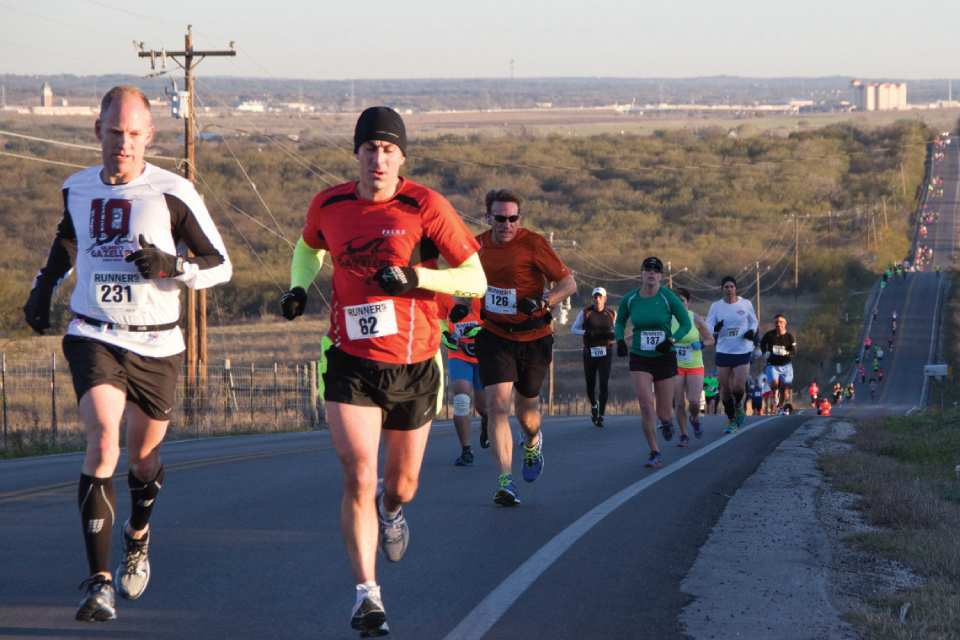Moe Johnson is Racing for Keeps

San Marcos resident and retired Texas State University professor Moe Johnson knows a thing or two about putting on a good race. This March will mark the 30th anniversary of his namesake event, Moe’s Better Half Marathon—the oldest, continuous half marathon in Texas.
Long distance races were hard to come by in the 1980s. Even harder was finding an event of any distance that was well organized. While joking about race mishaps he had encountered, Johnson recounted one in particular that stood out.
“(The race director) took a box of shirts and threw them on the ground, saying, ‘Here are your shirts,’” Johnson recalled. “When the runners finished, he handed them finish cards, but then they took them away. No one knew who won. Runners were saying, ‘I’ll never come back to San Marcos again.’”
Convinced there had to be a better way—and determined to have some fun at the same time—Johnson joined forces with a small group of runners to form the San Marcos Running Club. The group’s original intent was to organize its own races and social activities; however, they soon found themselves lending a hand to other organizations wanting to hold races of their own. “We bought a clock and the cones and finish chute, the timing system, the directional arrows,” Johnson said. “We do all the race organization; we measure the course for them…certify the race course if they need it.”

Johnson was not always a runner. In fact, it would be fair to say that, back in the day, his figure was not the lean physique typically associated with a distance runner. He was a champion weightlifter, wrestler, and body builder—winning state competitions and claiming titles such as Mr. North Dakota and Mr. Northern Plains during the 1960s. At the age of 50, Johnson rounded off his lifting career with a national title at the United States Powerlifting Federation’s Masters National Powerlifting Championships. A nagging shoulder injury ultimately affected Johnson’s weightlifting ability, and he turned to running as an alternative form of exercise.
“The first race I ran was the Capitol 10K,” he said. “I thought I was going to die.”
But Johnson didn’t die; instead, he began to challenge himself with longer distances. By 1984, he was running marathons. Dissatisfied with the small number of long-distance races available, he and fellow runner Brian McCoy decided it was time for the San Marcos Running Club to put on one of their own. “We didn’t know what to call the race,” Johnson said. “Brian just said, ‘We’ll call it Moe’s Better Half—it’s a better half marathon.’”
Anticipating around 50 runners for its inaugural year, Johnson and McCoy ordered 100 shirts. Soon, they realized that 150 runners had registered. “I said to Brian, ‘We’re in trouble,’” Johnson remembered.
They ordered another 100 shirts to accommodate the growing number of race entries, and then ordered an additional 100. The next year, they stocked 300 shirts, just to be on the safe side—and, again, found themselves scrambling for more to accommodate the 350 registrants. Although the race originally took place in the fall, they moved it to the spring at the suggestion of Austin running pioneer Paul Carrozza, thus extending the long-distance season. Today, runners competing in the Boston Marathon in April often use Moe’s Better Half as a training run.

Pulling off a successful race is no easy feat. Johnson admitted that it’s usually some small mishap—misunderstood directions, an overlooked detail—that throws a wrench into even the best-laid plans. Over the years, he and his fellow race organizers in the San Marcos Running Club have learned from these mistakes and now use those experiences when planning races for other organizations. “That’s what the runner’s club tries to do, make sure these little details are taken care of so they don’t have them,” he said.
The number of half marathons in central Texas has steadily grown over the years. Johnson said that the increased competition has impacted the number of participants in Moe’s Better Half, but the race’s good reputation (as well as its reasonable $50 entry fee) continues to attract a loyal following. Sweetening the pot this year is an upgrade in entry swag—an embroidered runner’s jacket. Like every year, any profits from the race go to charitable organizations, such as the Kiwanis club, for scholarships.
At the age of 76, Johnson shows no signs of slowing down. Although officially retired from teaching and consulting (for years he worked with national hockey leagues on abdominal injury prevention), he returned to Texas State last year as a lecturer in adaptive P.E. and kinesiology. He also writes a regular column called “Run With Moe” for the San Marcos Daily Record. The loss of cartilage in his knees means he has had to shift his exercise focus from running to walking and biking. Johnson said it’s been a difficult transition, but he’s making the best of it. He noted that his duties as a race organizer help him feel connected to the running world—and to him, that is most important.
“That’s why I like to put on these races. It keeps me in touch with the runners,” Johnson said. “It’s amazing how many of them I know from when I ran; they keep coming back to our races…I get to meet all the runners again. Some of them recall past races when we ran together. That’s part of why I like to help out.”






